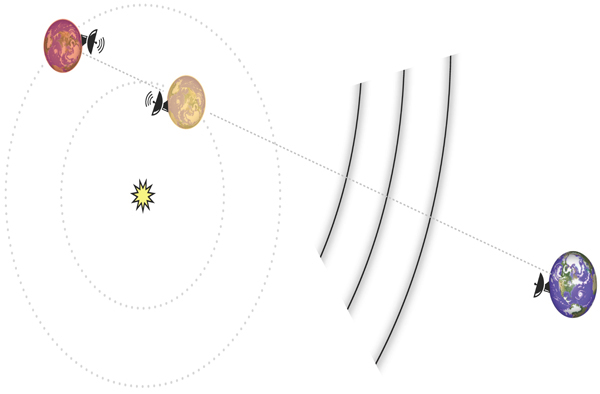Kepler’s New Planets: Is Anybody Home?
SETI researchers have already listened in for alien transmissions
/https://tf-cmsv2-smithsonianmag-media.s3.amazonaws.com/filer/58/48/5848bc8a-8564-443b-9722-da85823d25e5/kepler62f_nasa.jpg)
The Kepler team’s announcement of the smallest, most Earthlike planets yet discovered in a star’s habitable zone naturally got SETI-ologists wondering whether alien civilizations might be broadcasting from Kepler-62e or -62f.
It turns out that one SETI group has already listened for signals.
Two years ago, a team led by Andrew Siemion of the University of California at Berkeley trained the giant Robert C. Byrd Green Bank Telescope in West Virginia on 86 selected “Kepler objects of interest” — confirmed or suspected planets found by NASA’s orbiting telescope since its launch in 2009. The targets were chosen based on several criteria: if the planets were within a specific mild temperature range, or if they were just a little bigger than Earth and relatively far from their host star, or if the star had five or more candidate planets. One of the 86 stars on the list was an orange dwarf designated KOI 701, now better known as Kepler-62, home to the planetary system announced yesterday.
For each of the stars, the Green Bank telescope searched the entire frequency range between 1.1 and 1.9 gigahertz, listening for “narrow-band” signals no more than a few hertz wide, which, according to a paper by Siemion and his colleagues in The Astrophysical Journal, are, “as far as we know, an unmistakable indicator of engineering by an intelligent civilization.” Other SETI searches have targeted Kepler candidate planets, but the Green Bank search between February and April 2011 was the most sensitive yet.
Alas, “no signals of extraerrestrial origin were found” for KOI 701 or any of the other 85 targets, report the scientists. That’s not a surprising result in SETI, where absence of evidence is not evidence of absence.
So the search will continue. Having looked for narrow-band signals, the next step, says Siemion, is to hunt for other patterns in the data that would be harder to detect. Within the next couple of months, he and his colleagues plan to add their Kepler data to the SETI@Home archive, so that volunteers around the world can use their own computers to help crunch the numbers and look for signals.
Down the line, he sees other opportunities to tune in to the Kepler-62 planets. One scenario for possible alien transmissions is that extraterrestrial civilizations would use radio to communicate from one planet to another — if, like us, they’ve begun exploring their own solar system. Because we see the Kepler-62 system more or less edge-on, the planets will regularly line up with each other from our point of view, so that we can search at radio or even optical wavelengths for a beam directed from one planet to another. The next such conjunction of Kepler 62e and 62f happens on July 30.

If they're talking from one planet to another in the Kepler-62 system, we could listen in. (Courtesy Andrew Siemion)
“The Kepler planets are so exciting,” says Siemion, not just in themselves (although at 1,200 light years away, they’re too distant to explore in detail), but because they herald a new era of studying planets we know to be Earthlike in size and composition. He’s looking forward to the launch of TESS (the Transiting Exoplanet Survey Satellite) in 2017. While Kepler’s job is to collect statistics about how common planets are around distant stars, TESS will hunt for Earthlike worlds in our own celestial neighborhood — 10 or 15 light years away. That’s close enough, says Siemion, where SETI searches could pick up FM radio and television transmissions of the kind now leaking out from Earth every day.